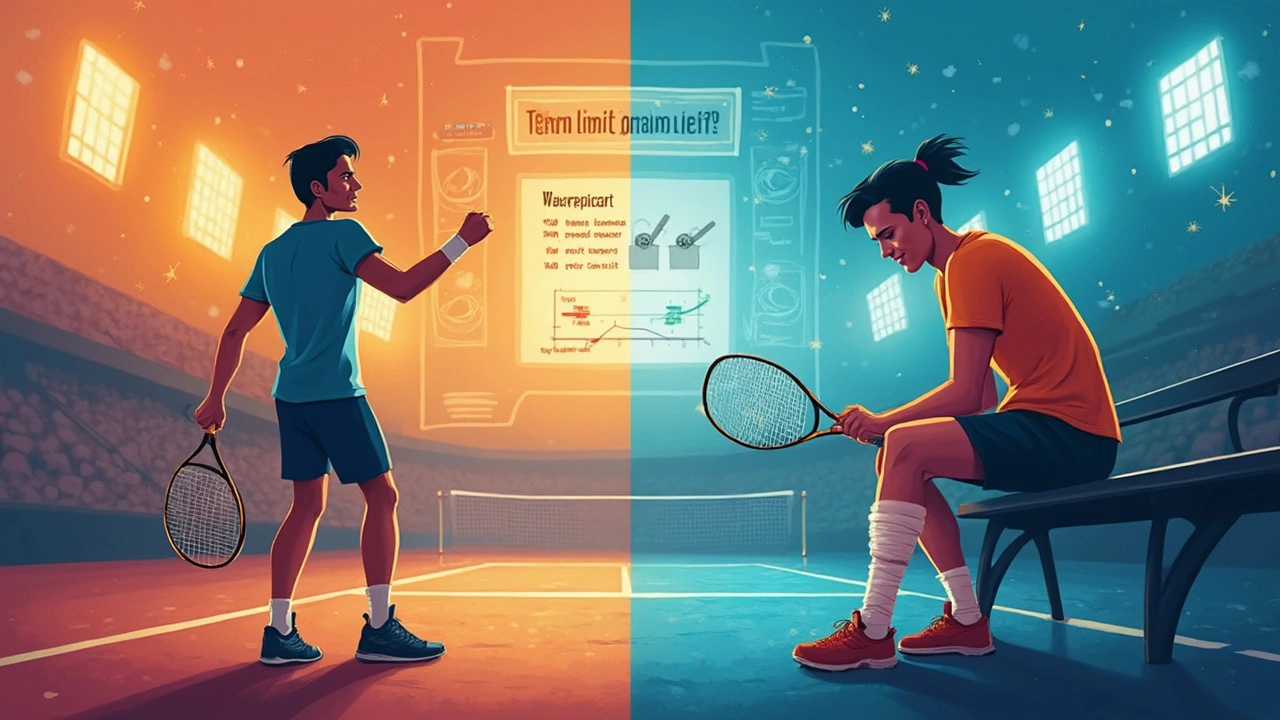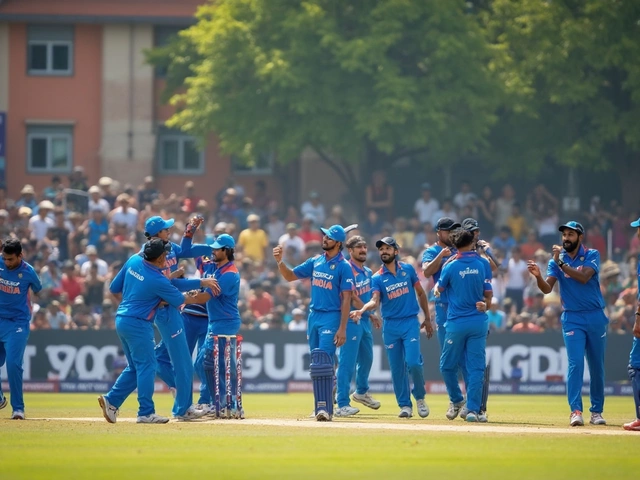If you think tennis players just roll up to any tournament they fancy, think again. There are rules, big points at stake, and plenty of strategy involved in choosing the right mix of events. The ATP and WTA don’t let top players skip out on major stops, and the season is packed with must-play events that can make or break a player’s ranking.
The number of tournaments a player enters isn’t just about grabbing trophies. It affects their ranking points, income, and their body’s ability to hold up through long, grueling months. Get it right, and you’re climbing the ranks. Get it wrong, and injuries or burnout are right around the corner. Wondering how many events are actually required or recommended? Let’s clear up the numbers—and spill some behind-the-scenes scheduling tactics the pros use.
- How Many Tournaments Are There?
- Required Events for ATP and WTA Players
- Smart Scheduling: Balancing Rest and Ranking
- Tips for Amateurs and Up-and-Coming Pros
How Many Tournaments Are There?
The tennis calendar is packed, especially at the pro level. If you’re wondering just how many tournaments exist in a season, here’s a look at the numbers: the ATP Tour and WTA Tour—men’s and women’s professional circuits—each have well over 60 tournaments a year, spread across continents. Throw in the Grand Slams, national team events, the Olympics, and loads of Challenger and ITF tournaments, and the landscape looks massive.
Check out this simple breakdown of the top-level events for 2025:
| Tour | Grand Slams | Mandatory Events | Other Major Events | Total ATP/WTA Main Tour Events* |
|---|---|---|---|---|
| ATP | 4 | 9 Masters 1000 | 13 ATP 500 39 ATP 250 | ~65 |
| WTA | 4 | 4 WTA 1000 Mandatory | 5 WTA 1000 non-mandatory 15 WTA 500 30 WTA 250 | ~60 |
*Numbers change a bit year by year, but these are the usual averages.
Besides these, hundreds of Challenger (ATP) and ITF lower-level events run all year, letting up-and-coming players or those outside the top 100 chase points and gain match experience.
- The tennis tournaments calendar can feel non-stop—there’s basically something happening every week except Christmas.
- Four Grand Slams stand out as “can’t miss”: the Australian Open, Roland-Garros, Wimbledon, and US Open. Miss one, and you lose big ranking points and prize money opportunities.
- National events like the Davis Cup, Billie Jean King Cup, and the Olympics rotate through the schedule too, sometimes bumping into regular tour weeks.
The takeaway? There are loads of events, but not every player enters the same ones. Choices depend on ranking, body, ambitions, and yes, sometimes just where in the world a player wants to be that month.
Required Events for ATP and WTA Players
If you’re aiming for the top in tennis, you don’t get to handpick every event. The ATP and WTA have specific rules about the tennis tournaments that count towards your ranking. Miss the wrong one and you risk a penalty—or worse, a big drop in the rankings.
Let’s break it down. For the men’s ATP Tour, top players have to show up for:
- The four Grand Slams: Australian Open, French Open, Wimbledon, and the US Open. These are non-negotiable if you’re healthy.
- The eight mandatory ATP Masters 1000 tournaments (Monte Carlo is optional for the ranking count, but most guys don’t skip it since it offers big points).
- Four ATP 500-level events are also required. You can choose which ones, but you can’t get away with skipping this tier if you want your points to add up.
WTA players—the top-tier women—face a similar system:
- The four Grand Slams, again, are required.
- Four WTA 1000 Mandatory events: Indian Wells, Miami, Madrid, and Beijing. You have to be there if you’re fit to play. Skipping means a zero-pointer in your rankings.
- Two WTA 1000 non-mandatory events. These aren’t as strict, but most top 20 players fill up their schedule with them for the points.
Here’s a quick overview of what’s expected from top players each season:
| Tour | Grand Slams | Mandatory 1000s | Other Required Events |
|---|---|---|---|
| ATP | 4 | 8 | 4 ATP 500s |
| WTA | 4 | 4 Mandatory WTA 1000s | 2 Non-Mandatory WTA 1000s* |
*Most top WTA players add two additional 1000-level tournaments to keep their scores up.
Rankings for both tours are built around your best 18 tournaments (16 if you’re outside the top 30), but if you skip a required event without a valid reason—think injury or personal crisis—a zero gets plugged into your total. That’s a killer for any ranking chase.
The rules do get a bit kinder as you get older—ATP players over 31 with long careers can skip up to one Masters 1000 for every 600 matches played. But for most pros, the required events set the backbone of their season.

Smart Scheduling: Balancing Rest and Ranking
Tennis players don’t just rack up as many tournaments as possible. There’s a number to aim for, and it’s all about fighting for those precious ranking points—without ending up injured or burned out. ATP players, for example, have their ranking made up from their results in the four Grand Slams, eight mandatory Masters 1000s, and their best six other results. WTA uses a similar formula, counting the Grand Slams, WTA 1000 mandatory events, and top-results from the rest. So, stacking more tournaments doesn’t always mean a higher ranking. Only your best results get counted.
This makes smart scheduling a must. Top pros often pick events where they’ve done well before, where the surface suits their game, or where travel won’t completely drain them. It’s not just about big cities and bright lights. They map out weeks off well in advance, especially around demanding tournaments or long-haul travel. You’ll see most players taking breaks after Grand Slams or that brutal US summer hard-court swing. Skipping the right tournament can save a season.
Some useful strategies players use:
- Target tournaments with weaker fields to sneak in more points.
- Prioritize rest weeks between busy stretches like clay and grass court seasons.
- Skip smaller tournaments if you’re deep in the Grand Slam or Masters draws—better to recover than risk injury for a few more points.
- Defend points where you scored big last season, but don’t chase every lost point—sometimes health wins out.
One of the most overlooked tricks? Planning for travel. Jet lag can kill your form faster than a bad serve, so smart players pick events to minimize crazy flights—choosing European tournaments in a row, or grouping US events together.
Even the biggest stars keep their calendar flexible. Injuries, surprise losses, or a hot streak can change plans on the fly. The very best aren’t just great with a racket—they’re masters at knowing when to push and when to put their feet up.
Tips for Amateurs and Up-and-Coming Pros
If you're dreaming of making it big on the tennis circuit or even just aiming for a strong amateur run, your tennis tournaments schedule can make or break you. Unlike the top pros who have agents and coaches plotting every move, most newcomers have to figure things out as they go. Still, there are some tried and tested tips that help you stand out (and hold up) over the season.
First off, don’t just sign up for every tournament in arm’s reach. Overplaying leads directly to injury and burnout—no matter your age or level. The International Tennis Federation (ITF) recommends that junior players, for instance, should not play more than 20 tournaments per year (including team events). For adults starting out, somewhere between 10 and 15 quality events gives you enough match play without wrecking your body.
- Plan ahead: Check entry deadlines and always have backup events in mind. Sometimes draws fill up fast.
- Target the right level: If you keep losing first round in higher-tier events, try more mid-level or lower-tier ones for confidence and points.
- Rest matters: Pros take scheduled weeks off. Copy this move—your game will thank you.
- Track progress: Keep notes on matches, fatigue, and improvement areas. Most pros use performance journals or apps.
- Mental game: Playing fewer, better-planned tournaments lets you approach each event with a fresher mindset.
Climbing out of the juniors or the lower-level pro events (like ITF Futures) is all about picking tournaments that fit your goals, not just your calendar. Here's how the season might look for different levels:
| Player Level | Average Tournaments/Year | Common Mistake |
|---|---|---|
| Junior | 12-20 | Playing too many local events |
| Collegiate | 10-15 | Burnout by spring season |
| Pro (ranked outside Top 200) | 18-28 | Chasing points with no rest period |
One more tip that separates the serious from the burnt out: listen to your body, not just your ranking. Many young players ignore signs of overuse and lose momentum for months. If you wake up sore after every event, it’s way better to take a week off rather than risk a stress injury. The tennis calendar is long—pace it smart, and you’ll get more wins in the end.





